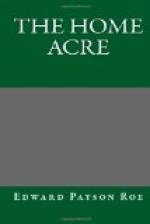There are many points in connection with this fruit which, in a small treatise like this, must be merely touched upon or omitted altogether. I may refer those who wish to study the subject more thoroughly to my work, “Success with Small Fruits.”
CHAPTER VIII
THE KITCHEN-GARDEN
The garden should be open to the sky, and as far as possible unshaded by adjacent trees from the morning and afternoon sun. It is even more essential that the trees be not so near that their voracious roots can make their way to the rich loam of the garden.
Now for the soil. We should naturally suppose that that of Eden was a deep sandy loam, with not too porous a subsoil. As we have already seen again and again, such a soil appears to be the laboratory in which we can assist Nature to develop her best products. But Nature has a profound respect for skill, and when she recognizes it, “lends a hand” in securing excellent crops from almost drifting sand or stubborn clay. She has even assisted the Hollander in wresting from the ocean one of the gardens of the world.
We must again dwell on the principles already emphasized, that soils must be treated according to their nature. If too damp, they must be drained; if of the fortunate quality of a sandy loam resting on a clay subsoil, they can be abundantly deepened and enriched from the start, if of a heavy clay, inclined to be cold and wet in spring, and to bake and crack in summer, skill should aim to lighten it and remove its inertia; finally, as we have shown, a light, porous soil should be treated like a spendthrift. All soils, except the last-named, are much the better for being enriched and deeply plowed or forked in October or November. This exposes the mould to the sweetening and mechanical action of frost, and the fertilizers incorporated with it are gradually transformed into just that condition of plant food which the rootlets take up with the greatest ease and rapidity. A light soil, on the contrary, should not be worked in autumn, but be left intact after the crops are taken from it.
In one respect a light soil and a stiff, heavy one should be treated in the same way, but for different reasons. In the first instance, fertilizers should be applied in moderation to the surface, and rains and the cultivation of the growing crops depended upon to carry the richness downward to the roots. The porous nature of the earth must ever be borne in mind; fertilizers pass through it and disappear, and therefore are applied to the surface, to delay this process and enable the roots to obtain as much nutriment as possible during the passage. Equal and even greater advantages are secured by a top-dressing of barnyard manures and composts to the heaviest of clay. The surface of such soils, left to Nature, becomes in hot, dry weather like pottery, baking and cracking, shielding from dew and shower, and preventing all circulation of air about the roots. A top-dressing prevents all this, keeps the surface open and mellow, and supplies not only fertility, but the mechanical conditions that are essential.




